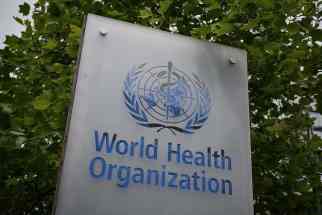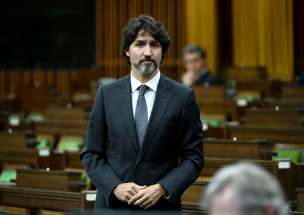Won’t get fooled again? WHO's damaged reputation will take time to heal
Read this article for free:
or
Already have an account? Log in here »
To continue reading, please subscribe:
Monthly Digital Subscription
$1 per week for 24 weeks*
- Enjoy unlimited reading on winnipegfreepress.com
- Read the E-Edition, our digital replica newspaper
- Access News Break, our award-winning app
- Play interactive puzzles
*Billed as $4 plus GST every four weeks. Offer only available to new and qualified returning subscribers. Cancel any time.
Read unlimited articles for free today:
or
Already have an account? Log in here »
Hey there, time traveller!
This article was published 10/06/2020 (1696 days ago), so information in it may no longer be current.
There’s one thing we’ve learned since the beginning of the COVID-19 pandemic: take what the World Health Organization says about the novel coronavirus with a grain of salt.
The WHO has been wrong or misleading on so many COVID-19 issues, it’s become almost impossible to rely on it as a trusted source of public health information.
The latest blunder came Monday, when Dr. Maria Van Kerkhove, WHO emerging diseases specialist, said the spread of the virus by asymptomatic people is “very rare” — a statement the world health body had to walk back the next day.
Her statement triggered a backlash in the scientific community, including from infectious disease experts who questioned why the WHO would make such a claim when the emerging science has shown the virus does spread asymptomatically.
The WHO made its retraction Tuesday, saying Van Kerhove’s statements were “misunderstood.” The WHO not only confirmed the virus can transmit from people who show no symptoms, it noted some studies have shown up to 40 per cent of transmissions could be asymptomatic.
That’s very different than claiming it’s “very rare.”
The executive director of WHO health emergencies program, Dr. Mike Ryan, clarified further Tuesday, saying the organization is “absolutely convinced” asymptomatic transmission is happening. He also said wearing a non-medical face mask can help reduce the spread of the disease.
This is the same Dr. Mike Ryan who, just over two months ago, urged the world not to wear such masks.
“There is no specific evidence to suggest that the wearing of masks by the mass population has any potential benefit,” he said in March. “In fact, there’s some evidence to suggest the opposite, in the misuse of wearing a mask properly or fitting it properly.”
The public would rather hear “the evidence is not clear on that,” instead of statements that appear to draw conclusions.
Granted, the science around the virus is evolving rapidly and there are many nuances around how information is conveyed. But it’s incumbent on public health officials not to make conclusive statements, or suggest they have answers based on incomplete data, when they really don’t know.
The public would rather hear “the evidence is not clear on that,” instead of statements that appear to draw conclusions.
The WHO got off to a rocky start Jan. 14, when it issued a statement on Twitter saying: “Preliminary investigations conducted by the Chinese authorities have found no clear evidence of human-to-human transmission of the novel coronavirus (2019-nCOV) identified in Wuhan, China.”
Six days later, Chinese officials confirmed the virus could spread between people. By then, it had already reached Beijing and Shanghai, and Japan, South Korea and Thailand.
There was at least some evidence Jan. 14 (when the WHO made its statement) the virus could be transmitted between people. Whether it was “clear evidence” or not doesn’t matter. Issuing a statement at the time, suggesting there was little chance of human-to-human transmission, was irresponsible and grossly misleading.
The WHO did the same thing in March, when it played down the likelihood of asymptomatic transmission.
“We do not believe that asymptomatic transmission is a major driver of transmission,” Van Kerkhove said during a March 5 briefing.
Using the term “major driver” is ambiguous. It suggests there was little chance of asymptomatic transmission at a time when there was emerging evidence to the contrary.
The WHO has been wrong or misleading on so many COVID-19 issues, it’s become almost impossible to rely on it as a trusted source of public health information.
This week wasn’t the first time the WHO had to walk back one of its statements.
In an April Twitter thread, it had played down the likelihood of immunity for those who recovered from the disease: “There is not enough evidence about the effectiveness of antibody-mediated immunity to guarantee the accuracy of an ‘immunity passport’ or ‘risk-free certificate.'”
Later that day, in response to “concerns” raised about its earlier remarks, the WHO issued a “clarification.”
“We expect that most people who are infected with #COVID19 will develop an antibody response that will provide some level of protection,” it said, taking down the earlier tweet.
The WHO deserves credit for correcting the record after the fact. But the number of times it has made inaccurate, misleading or confusing statements undermines its credibility as a public health authority. It has been sloppy.
It will take some time after this pandemic for the WHO to repair its damaged reputation.
tom.brodbeck@freepress.mb.ca

Tom Brodbeck
Columnist
Tom has been covering Manitoba politics since the early 1990s and joined the Winnipeg Free Press news team in 2019.
Our newsroom depends on a growing audience of readers to power our journalism. If you are not a paid reader, please consider becoming a subscriber.
Our newsroom depends on its audience of readers to power our journalism. Thank you for your support.






